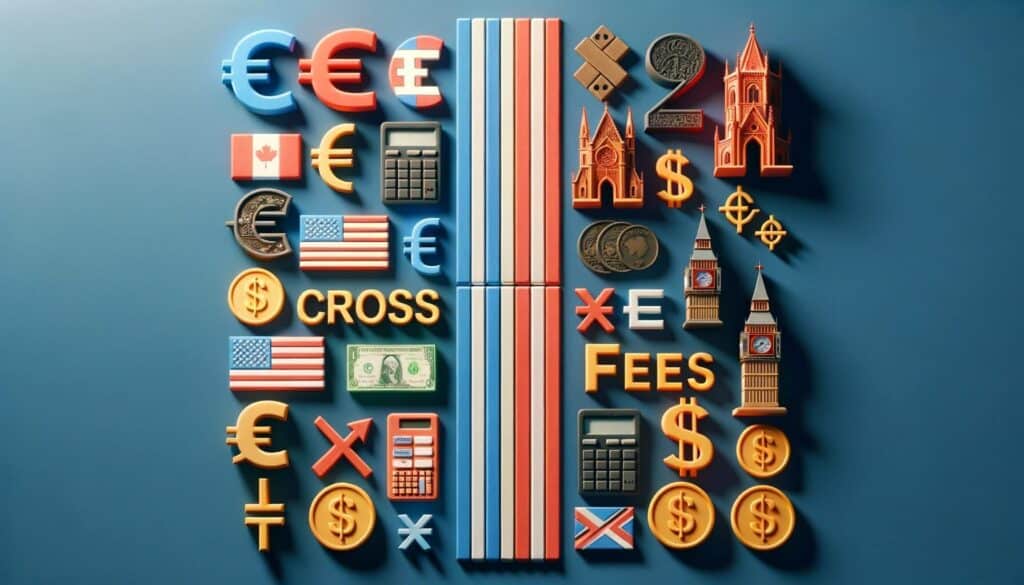
By Cindy Gardea February 14, 2025
In today’s globalized economy, businesses are increasingly conducting transactions across borders. Whether it’s an online retailer selling products to customers in different countries or a travel agency booking flights for international travelers, cross-border transactions have become a common occurrence. However, with these transactions come additional costs in the form of cross-border fees for credit card processing.
In this comprehensive guide, we will explore what cross-border fees are, how they impact merchants and consumers, the factors influencing these fees, different types of cross-border fees, how to calculate them, strategies to minimize them, common challenges and pitfalls, and address frequently asked questions.
Understanding the Basics: What are Cross Border Fees?

Cross-border fees, also known as international transaction fees, are charges imposed by credit card networks and payment processors for processing transactions that involve a foreign currency or a foreign merchant.
When a customer makes a purchase using their credit card in a different currency or from a merchant located in another country, the transaction goes through a complex process of currency conversion and settlement. The credit card networks and payment processors involved in this process charge fees to cover the costs and risks associated with these cross-border transactions.
How Cross Border Fees Impact Merchants and Consumers

Cross-border fees have a significant impact on both merchants and consumers. For merchants, these fees can eat into their profit margins and increase the cost of doing business internationally. The fees can vary depending on the credit card network, payment processor, and the specific terms of the merchant’s agreement. Merchants may also face additional challenges such as currency conversion costs, foreign exchange rate fluctuations, and potential delays in receiving funds from cross-border transactions.
On the consumer side, cross-border fees can result in higher prices for goods and services purchased from foreign merchants. These fees are typically passed on to the consumer by the merchant, either as a separate line item on the invoice or as part of the overall price. Consumers may also face additional costs due to currency conversion fees imposed by their credit card issuer or bank.
Factors Influencing Cross Border Fees

Several factors influence the cross-border fees charged by credit card networks and payment processors. These factors include:
1. Credit Card Network: Different credit card networks have their own fee structures for cross-border transactions. Visa, Mastercard, American Express, and Discover all have their own fee schedules, which can vary based on factors such as the country of the merchant, the currency involved, and the type of card used.
2. Payment Processor: The payment processor used by the merchant also plays a role in determining the cross-border fees. Payment processors may have their own fee structures or may pass on the fees charged by the credit card networks to the merchant.
3. Merchant Category: The type of business or industry the merchant operates in can also impact the cross-border fees. Some industries, such as travel and hospitality, may have higher fees due to the higher risk associated with these types of transactions.
4. Transaction Volume: The volume of cross-border transactions processed by a merchant can also influence the fees. Merchants with higher transaction volumes may be able to negotiate lower fees with their payment processor or credit card network.
Different Types of Cross Border Fees

There are several types of cross-border fees that merchants may encounter. These fees can vary depending on the credit card network and payment processor used. Some common types of cross-border fees include:
1. Cross-Border Transaction Fee: This fee is charged by the credit card network for processing a transaction that involves a foreign currency or a foreign merchant. It is typically a percentage of the transaction amount.
2. Currency Conversion Fee: When a transaction involves a currency conversion, the credit card network or payment processor may charge a fee for converting the currency. This fee is usually a percentage of the transaction amount.
3. Cross-Border Assessment Fee: This fee is charged by the credit card network to cover the costs associated with cross-border transactions. It is typically a fixed amount per transaction.
4. International Service Assessment Fee: This fee is charged by some credit card networks for transactions processed outside the cardholder’s country of residence. It is typically a percentage of the transaction amount.
How to Calculate Cross Border Fees
Calculating cross-border fees can be a complex process, as it involves multiple factors and fee structures. However, understanding the basic components of these fees can help merchants estimate the costs involved. The key factors to consider when calculating cross-border fees are:
1. Transaction Amount: The total amount of the transaction, including any taxes or fees, is a crucial factor in determining the cross-border fees. Most fees are calculated as a percentage of the transaction amount.
2. Credit Card Network Fees: Different credit card networks have their own fee structures for cross-border transactions. Merchants should consult the fee schedules provided by the credit card networks they work with to determine the applicable fees.
3. Payment Processor Fees: Payment processors may charge their own fees for processing cross-border transactions. These fees can vary depending on the payment processor and the specific terms of the merchant’s agreement.
4. Currency Conversion Costs: If the transaction involves a currency conversion, merchants should consider the costs associated with the conversion. This may include fees charged by the credit card network or payment processor for converting the currency, as well as any foreign exchange rate fluctuations.
Strategies to Minimize Cross Border Fees
While cross-border fees are an unavoidable cost of doing business internationally, there are several strategies that merchants can employ to minimize these fees:
1. Choose the Right Payment Processor: Merchants should carefully evaluate payment processors and their fee structures to find the one that offers the most competitive rates for cross-border transactions. It’s important to consider not only the transaction fees but also any additional fees or hidden charges.
2. Negotiate with Credit Card Networks: Merchants with high transaction volumes may be able to negotiate lower fees with credit card networks. It’s worth exploring this option and leveraging the merchant’s transaction volume as a bargaining tool.
3. Optimize Currency Conversion: If a merchant frequently deals with foreign currencies, it may be beneficial to explore options for optimizing currency conversion. This could involve using a third-party currency exchange provider or partnering with a payment processor that offers competitive currency conversion rates.
4. Consider Local Payment Methods: In some cases, offering local payment methods can help reduce cross-border fees. By allowing customers to pay in their local currency or through local payment systems, merchants can avoid or minimize currency conversion fees and other cross-border charges.
Common Challenges and Pitfalls with Cross Border Fees
While cross-border fees are a necessary part of international transactions, there are several challenges and pitfalls that merchants should be aware of:
1. Lack of Transparency: Cross-border fees can be complex and difficult to understand. Merchants may struggle to decipher the fee structures provided by credit card networks and payment processors, leading to unexpected costs and confusion.
2. Currency Conversion Risks: Currency conversion can introduce additional risks and costs for merchants. Fluctuations in exchange rates can impact the final amount received by the merchant, potentially resulting in losses or unexpected fees.
3. Compliance Requirements: Cross-border transactions may be subject to additional compliance requirements, such as anti-money laundering regulations or Know Your Customer (KYC) procedures. Merchants must ensure they are aware of and comply with these requirements to avoid penalties or disruptions in their business operations.
4. Limited Payment Options: Some countries may have limited payment options or restrictions on certain payment methods. This can make it challenging for merchants to offer a seamless payment experience to customers in those countries, potentially impacting sales and customer satisfaction.
Frequently Asked Questions about Cross Border Fees
Q1. Are cross-border fees the same for all credit card networks?
A1. No, different credit card networks have their own fee structures for cross-border transactions. Visa, Mastercard, American Express, and Discover all have their own fee schedules, which can vary based on factors such as the country of the merchant, the currency involved, and the type of card used.
Q2. Can merchants negotiate lower cross-border fees?
A2. Merchants with high transaction volumes may be able to negotiate lower fees with credit card networks. It’s worth exploring this option and leveraging the merchant’s transaction volume as a bargaining tool.
Q3. Are cross-border fees passed on to the consumer?
A3. Yes, cross-border fees are typically passed on to the consumer by the merchant. These fees may be listed as a separate line item on the invoice or included in the overall price of the goods or services.
Q4. Can merchants avoid cross-border fees altogether?
A4. It is difficult to completely avoid cross-border fees when conducting international transactions. However, merchants can employ strategies to minimize these fees, such as choosing the right payment processor, optimizing currency conversion, and offering local payment methods.
Conclusion
Cross-border fees for credit card processing are an integral part of conducting international transactions. Understanding the basics of these fees, their impact on merchants and consumers, the factors influencing them, different types of fees, how to calculate them, strategies to minimize them, and common challenges and pitfalls can help merchants navigate the complexities of cross-border transactions.
By carefully evaluating payment processors, negotiating with credit card networks, optimizing currency conversion, and considering local payment methods, merchants can minimize the impact of cross-border fees and provide a seamless payment experience to their customers around the world.
